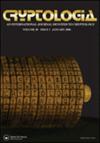简·斯利明的《美国密码破译者的秘密生活:密码破译女孩》
IF 0.4
4区 工程技术
Q4 COMPUTER SCIENCE, THEORY & METHODS
引用次数: 0
摘要
在2021年的《破解密码的女孩:布莱切利公园的秘密生活》中,简·斯利明的第一本关于二战密码破解的书出现了。Slimming对密码破译的兴趣,尤其是对布莱切利公园的兴趣,源于她的母亲Daisy Lawrence曾在布莱切利花园担任平民密码破译员。Slimming在她的第一本书中讲述了她母亲作为密码破译者的发现。第一本书还讲述了她的父亲斯坦利·摩尔的故事,他加入了皇家陆军服务团,在1942年新加坡沦陷期间被日本人俘虏,在战争的剩余时间里是一名战俘。不幸的是,Slimming试图将她母亲的故事扩展到第二次世界大战的大部分密码学历史中,但在试图这样做的过程中,她大错特错了。《破解密码的女孩:布莱切利公园的秘密生活》充满了错误和误解(克里斯滕森2022)。这本新书《破解密码的女孩》是根据二战期间美国海军密码破译员珍妮丝·马丁·贝纳里奥的故事改编的。如果读者在《秘密生活》的中途忘记了这本书的焦点——珍妮丝·贝纳里奥的故事——那将是情有可原的,因为就像她的第一本书一样,《瘦身》试图超越这本书,讲述一个更大的故事——在这种情况下,似乎是二战密码破译的完整故事等等。瘦身也使这本书充满了错误和误解。正如《布莱切利公园的秘密生活》的评论一样,不幸的是,有必要提供证据来证明瘦身的错误和误解。第九页:问题从“序言”的第二段开始。Slimming位于华盛顿特区宾夕法尼亚大道上被指定为主要海军的建筑。海军总部位于B街,即现在的宪法大道。这可能看起来是一个小错误,但这样的错误在整本书中都会出现。第38页:关于延迟收到1941年12月6日罗斯福总统给日本天皇的外交电文,Slimming解释说,由于该信息是用不太安全的美国外交格雷码编码的,美国驻日本大使Joseph Grew认为“日本激进分子截获了该信息,解决了其内容,并故意拖延,以阻碍任何和平努力。”,他说:“然而,真正的原因不是法规或外交官,而是对所有日本军方收到的外交信息实施了全面禁运。”(38)斯林对这一事件的大部分说法似乎都是基于卡恩的解释。(卡恩本文章由计算机程序翻译,如有差异,请以英文原文为准。
Review of The Secret Life of an American Codebreaker: Codebreaker Girls by Jan Slimming
In 2021 Codebreaker Girls: A Secret Life at Bletchley Park, Jan Slimming’s first book about World War II codebreaking appeared. Slimming’s interest in codebreaking and, in particular, in Bletchley Park resulted from the fact that her mother Daisy Lawrence had served as a civilian codebreaker at Bletchley Park. What Slimming discovered of her mother’s service as a codebreaker is told in her first book. The first book also includes a bit of the story of her father Stanley Moore, who joined the Royal Army Service Corps, was taken prisoner by the Japanese during the fall of Singapore in 1942, and was a POW during the remainder of the war. Unfortunately Slimming tried to expand the story of her mother to include much of the cryptologic history of World War II, and in trying to do so she went badly wrong. Codebreaker Girls: A Secret Life at Bletchley Park is filled with errors and misunderstandings (Christensen 2022). This new Codebreaker Girls book is built upon the story of Janice Martin Benario, a US Navy codebreaker during World War II. Readers would be forgiven if, part way through Secret Life, they lose track of what would appear to be the focus of the book – the story of Janice Benario – because, like her first book, Slimming has attempted to go beyond the foundation of the book and tell a larger story – in this case seemingly the complete story of World War II codebreaking and more. Slimming has also filled this book with errors and misunderstandings. As with the review of A Secret Life at Bletchley Park, it unfortunately becomes necessary to provide evidence of Slimming’s errors and misunderstandings. Page ix: Problems begin with the second paragraph of the “Prologue.” Slimming locates the building that is designated Main Navy on Pennsylvania Avenue in Washington, DC. Main Navy was located on B Street, which is now Constitution Avenue. This might seem like a minor error, but such errors pop up throughout the book. Page 38: Referring to a delay in the receiving of a 6 December 1941 diplomatic message from President Roosevelt to the Japanese Emperor, Slimming explains that because the message was encoded with the less secure US diplomatic GRAY code US Ambassador to Japan Joseph Grew thought that it was possible that “Japanese militants had intercepted the message, solved its contents and deliberately delayed it to hinder any peace effort.” (37–38) Slimming then, referencing David Kahn’s The Codebreakers page 495, says: “The real reason, however, was not the code or the diplomats but a full embargo placed on all Japanese military incoming diplomatic messages.” (38) Much of what Slimming says about this event seems to be based on Kahn’s explanation. (Kahn
求助全文
通过发布文献求助,成功后即可免费获取论文全文。
去求助
来源期刊

Cryptologia
工程技术-计算机:理论方法
自引率
33.30%
发文量
31
审稿时长
24 months
期刊介绍:
Cryptologia is the only scholarly journal in the world dealing with the history, the technology, and the effect of the most important form of intelligence in the world today - communications intelligence. It fosters the study of all aspects of cryptology -- technical as well as historical and cultural. The journal"s articles have broken many new paths in intelligence history. They have told for the first time how a special agency prepared information from codebreaking for President Roosevelt, have described the ciphers of Lewis Carroll, revealed details of Hermann Goering"s wiretapping agency, published memoirs - written for it -- of some World War II American codebreakers, disclosed how American codebreaking affected the structure of the United Nations.
 求助内容:
求助内容: 应助结果提醒方式:
应助结果提醒方式:


